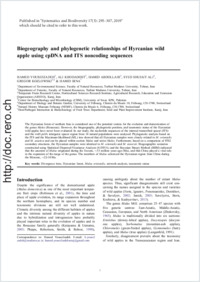Biogeography and phylogenetic relationships of Hyrcanian wild apple using cpDNA and ITS noncoding sequences
- Yousefzadeh, Hamed Department of Environmental Science
- Khodadost, Ali Department of Forestry, Faculty of Natural Resources, Tarbiat Modares University, Tehran, Iran
- Abdollahi, Hamid Temperate Fruits Research Center, Horticultural Sciences Research Institute, Agricultural Research, Education and Extension Organization (AREEO), Karaj, Iran
- Ali, Syed Shujait Center for Biotechnology and Microbiology (CBM), University of Swat, KPK, Pakistan
- Kozlowski, Gregor Department of Biology and Botanic Garden, University of Fribourg, Switzerland - Natural History Museum Fribourg, Switzerland
- Bina, Hamid Host/Pathogen Interaction & Biotechnology of Fruit Trees Department, Seed and Plant Improvement Institute, Karaj, Iran
-
03.04.2019
Published in:
- Systematics and Biodiversity. - 2019, vol. 17, no. 3, p. 295–307
English
The Hyrcanian forest of northern Iran is considered one of the potential centres for the evolution and domestication of the genus Malus (Rosaceae). However, the biogeography, phylogenetic position, and taxonomic status of the Hyrcanian wild apples have never been evaluated. In our study, the nucleotide sequences of the internal transcribed spacer (ITS) and the trnH-psbA intergenic spacer region from 14 natural populations were analysed. Phylogenetic analysis based on the ITS and the Maximum-likelihood (ML) tree showed that all Hyrcanian samples were closely related to M. orientalis and M. asiatica and can be placed within section Malus and series Malus. Furthermore, based on a comparison of ITS2 secondary structures, the Hyrcanian samples were identical to M. orientalis and M. sieversii. Biogeographic scenarios constructed using Statistical Dispersal-Vicariance Analysis (S-DIVA) and the Bayesian Binary Method (BBM) indicated that the ancestor of Malus originated during the Eocene, ∼53 million years ago (Ma), and that China played a vital role in the expansion of the range of the genus. The members of Malus colonized the Hyrcanian region from China during the Miocene, ∼22-10 Ma.
- Faculty
- Faculté des sciences et de médecine
- Department
- Département de Biologie
- Language
-
- English
- Classification
- Biological sciences
- License
-
License undefined
- Identifiers
-
- RERO DOC 326944
- DOI 10.1080/14772000.2019.1583689
- Persistent URL
- https://folia.unifr.ch/unifr/documents/307979
Statistics
Document views: 136
File downloads:
- pdf: 310
